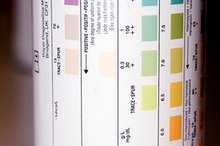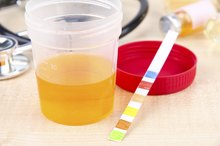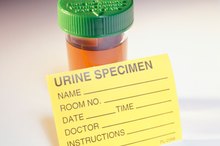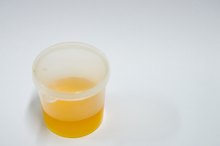How to Read a Urinalysis
A urinalysis is a test that is conducted at your doctor’s office that details various aspects of your health 1. A urinalysis can indicate problems with the kidneys or liver, an infection, chronic kidney disease, cystitis, cirrhosis, hepatitis, diabetes, and/or kidney stones. Once a urine sample is collected and a urinalysis is performed, the test compares different urine components against average or normal ranges. Reading a urinalysis takes a bit of work, but once understood, the test can prove quite revealing.
The Process
Collect one to two ounces of first morning urine in order to get the most accurate urinalysis reading possible. Dip a single dipstick into the urine and wait one minute for the chemical reaction to occur that causes the strip to change colors.
What Is Normal Amount of Protein in Urine?
Learn More
Observe the urine odor to detect the presence of ketones, indicated by an unusual, fruitlike smell. Notice the urine’s coloring: dark urine is indicative of dehydration, while clear-colored urine may suggest overhydration.
Review and compare the dipstick chemical tests with the dipstick color chart to assess pH levels, the specific gravity, nitrate levels, protein levels, ketone presence, glucose levels, blood, and hemoglobins.
Color of Urine Strips for Ketosis
Learn More
Document the information directly under the color strip indicator to compare with normal levels. Normal levels for specific gravity are between 1.0 and 1.03. The pH levels must fall between 4.8 and 7.5. A good protein, glucose, and ketone test should prove negative. The positive presence of the hormone HCG may indicate pregnancy.
Compare the pH value of the urine with an optimal pH range of 6.0; higher pH may mean the presence of a urinary tract infection, gout or a fever.
Look for the positive presence of nitrate levels in the urine; there should be no nitrate in a healthy urine sample.
Look for urobilinogen that exceeds 17 umol/l; excessive urobilinogens may indicate a problem with the liver such cirrhosis or partial functioning.
Check the bilirubin levels, which should be no higher than 3 umol/l; if the bilirubin is elevated., an anemic condition, liver problems, or hepatitis may be present.
Look at the leukocytes levels and make sure they fall in the range of 0 to 10; if the test is elevated and out of normal range, the sample may reveal a kidney infection.
View a slide containing some of the urine with a microscope. Look for the presence of white blood cells and red blood cells; white blood cells indicate a potential infection while red blood cells indicate blood presence in the urine and/or a problem with the kidneys. The presence of parasitic life forms might indicate a viral infection.
Tips
If you are reading the results of a urinalysis directly from a report, you will find that the information is listed in a specific order. The first item on the report will indicate the coloring of the urine. The next item on the report is called the “specific gravity” which indicates the concentration of ions in the urine sample; results higher than 1.03 may indicate the presence of ketoacidosis or protein in the urine.
Glucose levels, ketones, and proteins will be listed with either a negative or positive finding on a urinalysis report. The preferred finding is negative since a positive finding in any of the latter areas is cause for concern. High levels of ketones might suggest the presence of diabetes, binge drinking, or malnutrition. High glucose levels are also indicative of diabetes, but leukocytes levels also suggest an overconsumption of sugary foods or beverages, stress, and the presence of a fever. Excessive proteins might indicate disease of the kidney.
The report will list the exact pH levels detected beside the appropriate reference range; if the pH level falls between the numbers in the reference range, the reading is normal.
Nitrate levels will be noted with a positive or negative finding on a urinalysis report.
Warnings
Presence of blood in the urine might indicate poisoning or kidney damage. If more than 3 ery/ul of hemoglobin are found in your urine, further tests will be required to rule out renal failure and/or poisoning.
The presence of nitrate in your urine can mean a severe viral infection, bacterial infection, or a dangerous condition like E coli or Salmonella. Further testing will rule out such conditions..
- Collect one to two ounces of first morning urine in order to get the most accurate urinalysis reading possible.
- Look at the leukocytes levels and make sure they fall in the range of 0 to 10; if the test is elevated and out of normal range, the sample may reveal a kidney infection.
Related Articles
References
- Home Test Kits: A site explaining the various details of a urinalysis report.
- Lab Tests Online®: A site explaining how urinalysis tests are conducted and what the tests indicate.
- Cleveland Clinic. Urinalysis. Updated July 2018.
- Park S, Lee S, Lee A, et al. Preoperative dipstick albuminuria and other urine abnormalities predict acute kidney injury and patient outcomes. Surgery. 2018;163(5):1178-1185. doi:10.1016/j.surg.2017.12.002
- MedlinePlus. Urinalysis. Updated February 2019.
- MedlinePlus. Urine 24-hour volume. Updated July 2017.
- MedlinePlus. Urinary catheters. Updated January 2019.
- Witte EC, Lambers heerspink HJ, De zeeuw D, Bakker SJ, De jong PE, Gansevoort R. First morning voids are more reliable than spot urine samples to assess microalbuminuria. J Am Soc Nephrol. 2009;20(2):436-43. doi:10.1681/ASN.2008030292
- KidsHealth from Nemours. Urine test: Automated dipstick urinalysis.
- Cleveland Clinic. Blood sugar tests.
- UCLA Health. Complete urinalysis. Updated June 2018.
- Revollo JY, Lowder JC, Pierce AS, Twilla JD. Urine discoloration associated with metronidazole a rare occurrence. J Pharm Technol. 2014;30(2):54–56. doi:10.1177/8755122513500921
- Cleveland Clinic. Urine changes. Updated January 2020.
- Cavanaugh C, Perazella MA. Urine sediment examination in the diagnosis and management of kidney disease: Core curriculum 2019. Am J Kidney Dis. 2019;73(2):258-272. doi:10.1053/j.ajkd.2018.07.012
- MedlinePlus. Clean catch urine sample. Updated January 2018.
- UK National Health Service. How should I collect and store a pee (urine) sample?. Updated August 2019.
- KidsHealth from Nemours. Urine Test: Routine Culture.
- MedlinePlus. Urine - abnormal color. Updated July 2019.
- Urology Care Foundation of the American Urological Association. The meaning behind the color of urine. Updated August 2018.
- Al-badr A, Al-shaikh G. Recurrent urinary tract infections management in women: A review. Sultan Qaboos Univ Med J. 2013;13(3):359-67. doi:10.12816/0003256
- Vaginal infections. Girls Health. US Department of Health and Human Services. Updated May 2014.
- Parnham A, Serefoglu EC. Retrograde ejaculation, painful ejaculation and hematospermia. Transl Androl Urol. 2016; 5(4): 592–601. doi:10.21037/tau.2016.06.05
- Najeeb S, Munir T, et al. Comparison of urine dipstick test with conventional urine culture in diagnosis of urinary tract infection. J Coll Physicians Surg Pak. 2015;25(2):108-10. doi: 02.2015/JCPSP.108110
- Ko DH, Jeong TD, Kim S, et al. Influence of vitamin C on urine dipstick test results. Ann Clin Lab Sci. 2015;45(4):391-5.
- Foley KF, Wasserman J. Are unexpected positive dipstick urine bilirubin results clinically significant? A retrospective review. Lab Med. 2014;45(1):59-61. doi:10.1309/lml85xx1qbercirn
- Delanghe J, Speeckaert M. Preanalytical requirements of urinalysis. Biochem Med (Zagreb). 2014;24(1):89-104. doi:10.11613/BM.2014.011
- American Urological Association. Diagnosis, Evaluation and Follow-up of Asymptomatic Microhematuria (AMH) in Adults (2016).
- MedlinePlus. Glucose in urine test. Updated February 2020.
- Hiorns MP. Imaging of the urinary tract: the role of CT and MRI. Pediatr Nephrol. 2011;26(1):59-68. doi:10.1007/s00467-010-1645-4
- American Cancer Society. Tests for bladder cancer. Updated January 2019.
- College of American Pathologists. (2016) CAP Accreditation Program: Urinalysis Checklist. Northfield, Illinois: College of American Pathologists.
- Pallin, D.; Ronan, C.; Montazeri, K. et al. Urinalysis in Acute Care of Adults: Pitfalls in Testing and Interpreting Results. Open Forum Infect Dis. 2014: 1(1): ofu019. DOI: 10.1093/ofid/ofu019.
Tips
- If you are reading the results of a urinalysis directly from a report, you will find that the information is listed in a specific order. The first item on the report will indicate the coloring of the urine. The next item on the report is called the "specific gravity" which indicates the concentration of ions in the urine sample; results higher than 1.03 may indicate the presence of ketoacidosis or protein in the urine. Glucose levels, ketones, and proteins will be listed with either a negative or positive finding on a urinalysis report. The preferred finding is negative since a positive finding in any of the latter areas is cause for concern. High levels of ketones might suggest the presence of diabetes, binge drinking, or malnutrition. High glucose levels are also indicative of diabetes, but leukocytes levels also suggest an overconsumption of sugary foods or beverages, stress, and the presence of a fever. Excessive proteins might indicate disease of the kidney. The report will list the exact pH levels detected beside the appropriate reference range; if the pH level falls between the numbers in the reference range, the reading is normal. Nitrate levels will be noted with a positive or negative finding on a urinalysis report.
Warnings
- Presence of blood in the urine might indicate poisoning or kidney damage. If more than 3 ery/ul of hemoglobin are found in your urine, further tests will be required to rule out renal failure and/or poisoning. The presence of nitrate in your urine can mean a severe viral infection, bacterial infection, or a dangerous condition like E coli or Salmonella. Further testing will rule out such conditions..
Writer Bio
Robin Reichert is a certified nutrition consultant, certified personal trainer and professional writer. She has been studying health and fitness issues for more than 10 years. She holds a Bachelor of Arts in psychology from the University of San Francisco and a Master of Science in natural health from Clayton College.








